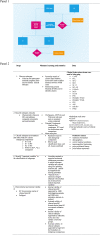Utilization of machine learning for identifying symptom severity military-related PTSD subtypes and their biological correlates
- PMID: 33879773
- PMCID: PMC8058082
- DOI: 10.1038/s41398-021-01324-8
Utilization of machine learning for identifying symptom severity military-related PTSD subtypes and their biological correlates
Abstract
We sought to find clinical subtypes of posttraumatic stress disorder (PTSD) in veterans 6-10 years post-trauma exposure based on current symptom assessments and to examine whether blood biomarkers could differentiate them. Samples were males deployed to Iraq and Afghanistan studied by the PTSD Systems Biology Consortium: a discovery sample of 74 PTSD cases and 71 healthy controls (HC), and a validation sample of 26 PTSD cases and 36 HC. A machine learning method, random forests (RF), in conjunction with a clustering method, partitioning around medoids, were used to identify subtypes derived from 16 self-report and clinician assessment scales, including the clinician-administered PTSD scale for DSM-IV (CAPS). Two subtypes were identified, designated S1 and S2, differing on mean current CAPS total scores: S2 = 75.6 (sd 14.6) and S1 = 54.3 (sd 6.6). S2 had greater symptom severity scores than both S1 and HC on all scale items. The mean first principal component score derived from clinical summary scales was three times higher in S2 than in S1. Distinct RFs were grown to classify S1 and S2 vs. HCs and vs. each other on multi-omic blood markers feature classes of current medical comorbidities, neurocognitive functioning, demographics, pre-military trauma, and psychiatric history. Among these classes, in each RF intergroup comparison of S1, S2, and HC, multi-omic biomarkers yielded the highest AUC-ROCs (0.819-0.922); other classes added little to further discrimination of the subtypes. Among the top five biomarkers in each of these RFs were methylation, micro RNA, and lactate markers, suggesting their biological role in symptom severity.
Conflict of interest statement
C.R.M. has received research and clinical program funding from National Institute on Alcohol Abuse and Alcoholism (NIAAA), National Institute of Mental Health (NIMH). Department of Defense (DoD), U.S. Army Medical Research & Acquisition Activity (USAMRA), U.S. Army Telemedicine & Advanced Technology Research Center (TATRC), Steven & Alexandra Cohen Foundation, Cohen Veterans Bioscience (CVB). Cohen Veterans Network (CVN), Robin Hood Foundation. McCormick Foundation, Home Depot Foundation, Bank of America Foundation, Brockman Foundation, Mother Cabrini Foundation, City of New York, has served as a PTSD Fellow for the George W. Bush Institute, is serving on the Scientific Advisory Board, and has equity in Receptor Life Sciences, Inc. is serving on the Clinical Science Advisory Group for Otsuka Pharmaceuticals. C.R.M. and has a pending patent (WO2017172487A1) entitled “Detecting or treating post-traumatic stress syndrome.” K.J.R. serves on advisory boards for Takeda, Janssen, and Verily, and has received sponsored research support from Alkermes, Alto Neuroscience, and Brainsway. He receives funding from the National Institute of Health (NIH) and the Brain and Behavior Research Fund.
Figures
References
Publication types
MeSH terms
Grants and funding
- W81XWH-18-C-0160/United States Department of Defense | U.S. Army (United States Army)
- W911NF-17-1-0069/United States Department of Defense | U.S. Army (United States Army)
- W81XWH-18-C-0160/United States Department of Defense | U.S. Army (United States Army)
- W911NF-17-1-0069/United States Department of Defense | U.S. Army (United States Army)
- W81XWH-18-C-0160/United States Department of Defense | U.S. Army (United States Army)
- W911NF-17-1-0069/United States Department of Defense | U.S. Army (United States Army)
- W81XWH-18-C-0160/United States Department of Defense | U.S. Army (United States Army)
- W911NF-17-1-0069/United States Department of Defense | U.S. Army (United States Army)
- W81XWH-18-C-0160/United States Department of Defense | U.S. Army (United States Army)
- W911NF-17-1-0069/United States Department of Defense | U.S. Army (United States Army)
- W81XWH-18-C-0160/United States Department of Defense | U.S. Army (United States Army)
- W911NF-17-1-0069/United States Department of Defense | U.S. Army (United States Army)
- W911NF-17-1-0069/United States Department of Defense | U.S. Army (United States Army)
- W81XWH-18-C-0160/United States Department of Defense | U.S. Army (United States Army)
- W81XWH-18-C-0160/United States Department of Defense | U.S. Army (United States Army)
- W911NF-17-1-0069/United States Department of Defense | U.S. Army (United States Army)
- W81XWH-18-C-0160/United States Department of Defense | U.S. Army (United States Army)
- W911NF-17-1-0069/United States Department of Defense | U.S. Army (United States Army)
- W81XWH-18-C-0160/United States Department of Defense | U.S. Army (United States Army)
- W911NF-17-1-0069/United States Department of Defense | U.S. Army (United States Army)
- W81XWH-18-C-0160/United States Department of Defense | U.S. Army (United States Army)
- W911NF-17-1-0069/United States Department of Defense | U.S. Army (United States Army)
- W81XWH-18-C-0160/United States Department of Defense | U.S. Army (United States Army)
- W911NF-17-1-0069/United States Department of Defense | U.S. Army (United States Army)
- W81XWH-18-C-0160/United States Department of Defense | U.S. Army (United States Army)
- W911NF-17-1-0069/United States Department of Defense | U.S. Army (United States Army)
- W81XWH-18-C-0160/United States Department of Defense | U.S. Army (United States Army)
- W911NF-17-1-0069/United States Department of Defense | U.S. Army (United States Army)
- W81XWH-18-C-0160/United States Department of Defense | U.S. Army (United States Army)
- W911NF-17-1-0069/United States Department of Defense | U.S. Army (United States Army)
- W911NF-17-1-0069/United States Department of Defense | U.S. Army (United States Army)
- W81XWH-18-C-0160/United States Department of Defense | U.S. Army (United States Army)
LinkOut - more resources
Full Text Sources
Other Literature Sources
Medical
Miscellaneous


